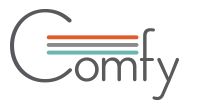As real estate leaders plan for the gradual return of employees to the workplace, a structured re-entry program will be vital to ensuring the safety and wellbeing of the workforce. Employers will need to establish clear occupancy limits supported by strict scheduling, physical distancing, and health safety measures in order to reduce the density of people inside the office at any given time. To ensure business continuity at this stage of the “new normal,” corporate real estate leaders will need to find the right balance between employee needs, evolving regulations, and physical limitations of their space.
The Comfy and Siemens teams are at the front and center of this conversation with our enterprise clients. Below, we’ve compiled some key considerations for this critical re-entry period.
Modify building access schedules to limit density.
One of the most commonly discussed strategies for workplace re-entry is a gradual move back into the office through rotational and staggered shifts so that fewer employees are on location at any given time. Many of our clients are targeting 20-30% occupancy in the near-term and don’t foresee going above 50% by year end.
As Doug Demers, Managing Principal at B+H Architects, recently said to the NYTimes, “There will be a higher value around spaces where we come together.” In order to optimize for both safe physical distancing and collaboration, business leaders must be strategic in creating employee ‘in-office’ shifts to foster the most fruitful collaboration and innovation. Assigning employee “cohorts” or teams that collaborate frequently is the first step to ensuring a successful transition.
Alternating work schedules can take many forms, and can have advantages and disadvantages based on the industry and business needs. Some real estate leaders are opting for a 4-day workweek in 10-hour shifts as one of the ways to lower occupancy levels. A significant number of clients are opting for alternating in-office and work-from-home days in regular 8-hour shifts. For industries with higher needs of cross-team collaboration, there are plans to split the five-day workweek into morning and afternoon shifts, with Team A working from the office from 6am-12pm and Group B working from 2pm-8pm, with a two-hour cleaning window scheduled in between.
With any of these strategies, monitoring building occupancy levels through WiFi analytics, IoT technology, sensors and office access solutions are crucial to ensuring limited employee density and the health and safety of employees.
Implement policies and workplace design to maintain physical distancing.
Once employees make their way into the office, proximity reduction measures must be in place to ensure physical distance is maintained and interactions are kept to a minimum. Real estate leaders will most likely have to reconfigure and manage the physical space. Real estate leaders around the world are currently mapping out workplace design layouts to identify the most optimized plan for their various workspaces around the world. Some companies are leaning on consulting firms like Gensler to use generative algorithms to find the most optimal layout, while others are removing workstations and seating to maintain the CDC-mandated six-foot radius around each employee. Regardless, having a plan to reduce proximity will be a necessary first step.
Depending on the office layout and employee density considerations, transitioning to unassigned seating to accommodate for alternating work schedules and increased square footage dedicated to each employee may be necessary. In these cases, leveraging a configurable desk and room booking system can be of great benefit. Using this technology, employees will be able to see which seats are available based on distancing guidance, and be guided to the section of the building assigned to their function.
Real estate leaders will also need to consider the flow of movement within the office to prevent bottlenecks. Assigning one-way traffic to hallways, setting capacity limits to shared spaces like kitchens and bathrooms, and having the ability to direct employees to low density areas are some consideration points.
In addition to physical signs, employers can use navigation tools to provide employees with customized directions to help them move through the office efficiently and safely. A fully integrated system could simply deny access to additional staff until the number of occupants has gone below a set threshold.
Build employee trust by promoting health and wellbeing measures
Many employees may be experiencing significant anxiety about the return to the workplace; will spaces be clean? Will they be able to be physically distanced from people on their way to and inside the office? Ultimately, technology can serve as a valuable tool in empowering employees to choose and control their surroundings, which will in turn provide much-needed psychological safety in the workplace.
Room and desk booking technology can be configured to ensure that only sanitized spaces can be accessed by employees. After a meeting takes place, time can automatically be blocked out to allow the space to be disinfected, and cleaning crews can be deployed in real time based on room use. Only when desks and spaces are safe will employees be able to book desks and rooms, giving both employees and employers peace of mind.
Mobile phones can serve as information hubs, access keys, and an array of other tools, empowering each employee with control over a multitude of workplace needs through a personal device, reducing the number of touchpoints through the workplace. For example, employers can easily inform employees of the availability of items like masks, disinfectants and cleaning supplies through a quick-link on an app homescreen, and navigate employees to the closest distribution point. Reminders can also be sent out to instruct employees to help contribute to workplace safety with helpful practices like cleaning their work stations after each use, and reporting anything that seems unsafe as employees go about their day.
For real estate executives, the data-driven management of space will enable business continuity, ensuring employee safety and resource efficiency. The ability to quickly identify problem areas, make real-time adaptations, and communicate and enforce those changes to the workforce will allow employers to efficiently and effectively navigate the new normal of the workplace. On how to use space data to manage an increasingly dynamic workplace, read more here.
For more COVID-19 workplace resources, view Comfy's Return to Workplace Playbook.

 Request a Demo
Request a Demo






